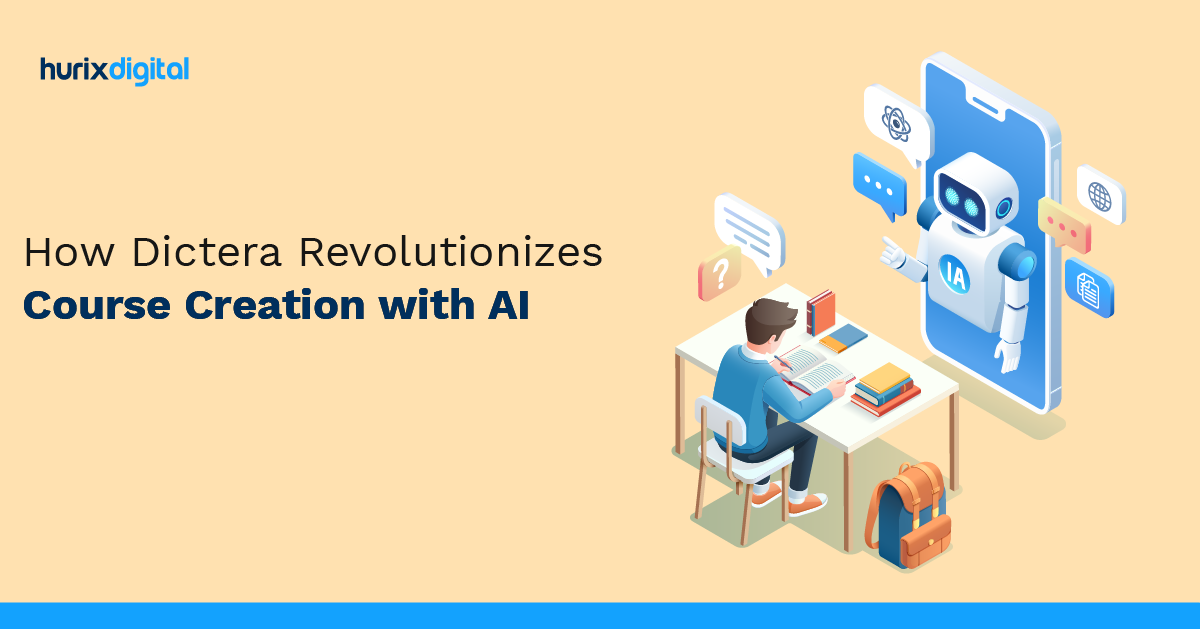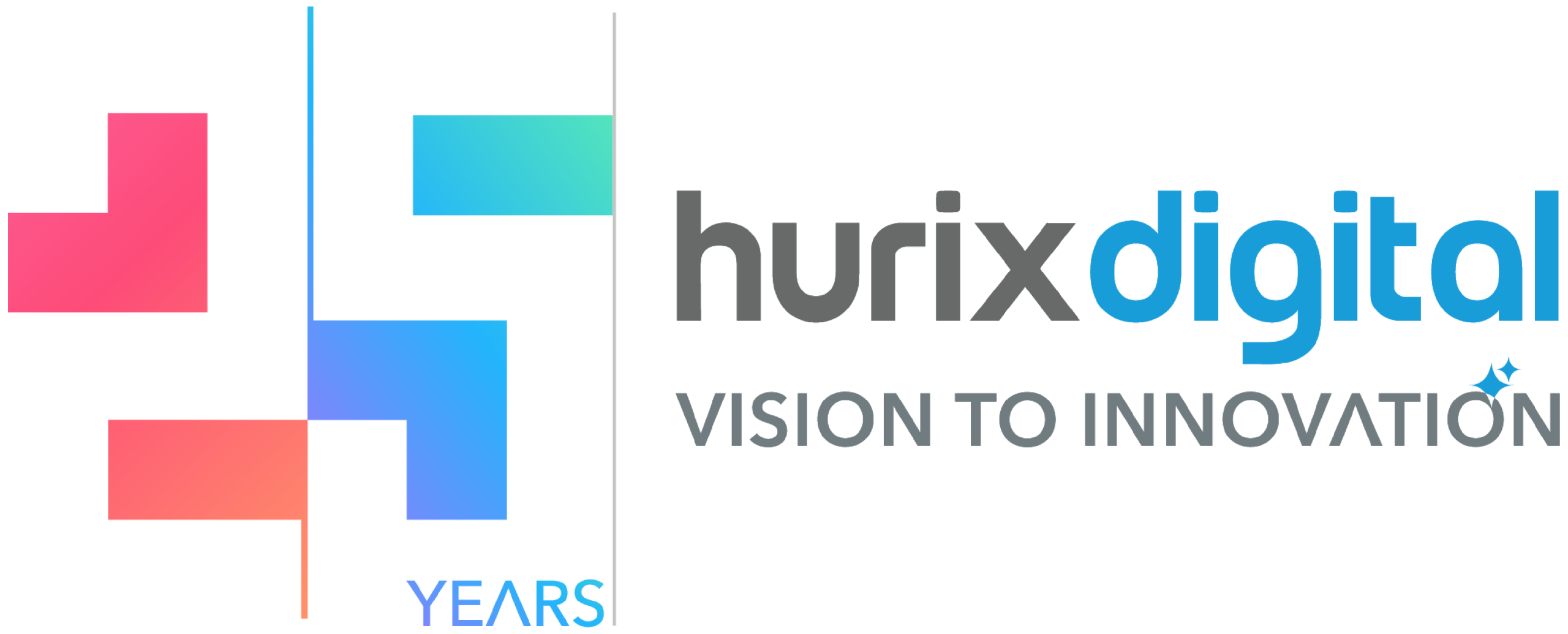
How Dictera Revolutionizes Course Creation with AI
Picture this: You’re an instructional designer squinting at an empty document while a countdown clock ticks in your head. You’ve got to crank out 50 courses before the calendar says December. Your coffee’s a tepid memory, your inbox has mutated into a never-ending loop of revision notes, and a quiet voice keeps asking, “Is there a smarter way to tackle this mountain?”
There is. And it goes by the name of Dictera.
Now, before you roll your eyes thinking this is another “AI will solve everything” pitch, hear me out. Dictera, Hurix Digital’s newest platform, does something genuinely different. It doesn’t try to replace the human touch in education. Instead, Dictera boosts what great teachers and designers already do best. Picture it as a tireless assistant that takes care of the busy work, so you can spend more time building learning experiences that really make a difference for people.
The real game-changer? Organizations using Dictera create better courses, maintain stricter quality standards, and keep their instructional design teams happier while also working faster. When you remove the tedious parts of course creation, people can focus on the creative, meaningful work they signed up to do in the first place.
Table of Contents:
- How Does Dictera AI Accelerate Course Creation Timelines?
- What Quality Standards Does Dictera AI Ensure for Courses?
- Can Dictera AI Scale Course Development for Large Organizations?
- What’s the ROI of Implementing Dictera AI in Education?
- How Does Dictera AI Protect Content Intellectual Property?
- Is Dictera AI Compatible With Our Existing LMS Systems?
- How Does Dictera AI Impact Instructional Designer Roles?
- What Unique AI Features Enhance Learner Engagement With Dictera?
- How Does Dictera AI Maintain Course Content Accuracy and Relevance?
- What is Dictera AI’s Future Roadmap for Educational Technology?
- The Bottom Line: Transformation, Not Just Automation
How Does Dictera AI Accelerate Course Creation Timelines?
Let’s discuss numbers that make CFOs smile and instructional designers breathe easier. For traditional course development, you’re looking at a minimum of 3-6 months per course. With Dictera, teams regularly complete the same scope in a matter of weeks.
But here’s what those numbers don’t tell you: it’s not about rushing. The acceleration happens because Dictera eliminates the stops and starts that plague typical projects. As usual, you have to wait for Jenny to review Module 3, search through seventeen email threads to find the latest version, and start over because someone changed the requirements halfway through.
Dictera’s AI generates that intimidating first draft based on your course map or existing materials. You get actual, contextually relevant content aligned with your learning objectives rather than generic filler. After using Dictera for a few weeks, one esteemed professor told us, “It’s like having a really smart intern who actually read all the reference materials.”. The AI produces modules complete with examples, assessments, and even interactive elements. All in minutes, not days.
Here’s the clever bit: while you’re reviewing the introduction, Dictera’s already generating Chapter 2 in the background. No thumb-twiddling, no progress bars to watch. As any project manager knows, momentum is gold.
The collaboration features deserve their own applause. Have you ever played telephone as a child and had a hilariously garbled message? Traditional course development often feels similar, except nobody’s laughing when deadlines slip. Dictera puts everyone in the same digital room. The author writes, the reviewer comments, and the publisher prepares. This all happens simultaneously and in sync.
What Quality Standards Does Dictera AI Ensure for Courses?
“But what about quality?” you wonder. Fair question. We’ve all seen AI-generated content that reads like it was written by a robot having an existential crisis. With Dictera, AI’s strengths are acknowledged while human expertise is respected.
The platform’s AI generates content that meets your specific standards rather than just churning out tepid text. Whether you’re following academic accreditation requirements in the Midwest or medical training protocols in Mumbai, Dictera adapts. The system trains on your organization’s standards, checking every piece of content against customizable compliance checklists.
The important thing to remember is that Dictera never claims AI is enough on its own. The platform builds in human review at every critical juncture. Subject matter experts can track changes, leave comments, and flag issues without the version control nightmares that usually accompany collaborative editing.
Several organizations report that courses created with Dictera actually exceed their previous quality standards. Why? When instructional designers aren’t burdened with formatting and administrative tasks, they can focus on what really matters: creating effective learning environments.
Can Dictera AI Scale Course Development for Large Organizations?
Here’s where things get interesting for the big players. If you’re managing ten courses, almost any system works. But what about 1,000 courses? Or 10,000? That’s where traditional approaches collapse under their own weight.
Dictera’s architecture thinks big from the start. With its project-based structure, courses can be grouped logically by department, compliance requirement, and target audience. Each project can have its own workflow, standards, and team. A massive university might run fifty projects simultaneously without anyone stepping on anyone else’s toes.
The role-based access control sounds boring until you’ve lived through the alternative. Authors see their authoring tasks. Reviewers see what needs reviewing. Publishers see what’s ready to publish. No more “Who’s supposed to be working on this?” or “Why did someone change my content?” Clear lanes, clear responsibilities, clear progress.
Here’s the kicker: Dictera actually gets better as you scale. The AI learns from your organization’s patterns. After creating fifty nursing courses, it understands your institution’s approach to healthcare education. After a hundred business courses, it knows your case study style. This institutional knowledge accumulates, making course number 104 easier to create than course number 1.
The cloud infrastructure handles the technical scaling invisibly. Whether your team creates ten courses on Monday or a hundred, the system doesn’t blink. No performance degradation, no mysterious crashes during crunch time. Just consistent, reliable performance that lets your team focus on content, not infrastructure.
What’s the ROI of Implementing Dictera AI in Education?
Let’s talk money. Even in education, budgets matter. Organizations typically see cost reductions of 40-60% in course development within year one. But those percentages hide the real story.
One mid-sized university shared its numbers: Five instructional designers previously produced 25 courses annually. Post-Dictera? Same team, 70+ courses. That’s working smarter rather than working harder.
But direct labor savings are just the beginning. Faster course development means faster response to market needs. When a new certification requirement emerges, you can have training ready in weeks, not months. For corporate training departments, this agility translates directly to reduced compliance risks. For universities, it means being first to market with programs addressing emerging skills gaps.
The hidden ROI often proves most valuable. Better courses lead to improved learning outcomes, which boost student satisfaction and institutional reputation. One online program director noted that their course completion rates increased 25% after implementing Dictera.
Measure your training effectiveness now! Use our free completion rate calculator to identify improvement areas.
How Does Dictera AI Protect Content Intellectual Property?
Let’s address the elephant in the room: “What happens to our content once we upload it?” In an era of data breaches and AI models trained on everything they can scrape, this concern is entirely valid.
Dictera takes a fundamentally different approach than consumer AI tools. Think of it as your own private island in the cloud for each organization. There is no way other clients can access your content, AI customizations, or institutional knowledge. There’s no “shared learning” across organizations, no risk of your competitor benefiting from your curriculum innovations.
The access controls go deep. You decide who sees what, who can edit, and who can publish. Every action gets logged. If someone copies Chapter 3 at 2:47 PM on Tuesday, there’s a record.
For organizations with enhanced security needs, private cloud deployments are available. Keep everything within your own infrastructure while still benefiting from AI assistance. Some government agencies and healthcare organizations require this level of control, and Dictera delivers without forcing compromises.
The AI training respects boundaries, too. When you upload existing content or course maps, that material trains only your instance of the AI. Your competitor using Dictera won’t suddenly start producing courses that sound suspiciously like yours. In fact, you can even run in completely closed mode without learning from uploads, just pure AI assistance.
Is Dictera AI Compatible With Our Existing LMS Systems?
“Great, another system to integrate,” nobody ever said enthusiastically. The good news: Dictera plays nicely with others. Really nicely.
The platform speaks fluent SCORM and Common Cartridge, the lingua franca of e-learning. Whether you’re running Canvas, Blackboard, Moodle, or that obscure learning management system (LMS) your institution adopted in 2003 and can’t seem to escape, Dictera-created courses import without drama. No proprietary formats holding your content hostage.
The API architecture opens interesting possibilities for organizations wanting deeper integration. Some pull course content directly into their LMS, while others push assessment results back to Dictera for analysis. This bidirectional flow creates a coherent ecosystem without the spaghetti-code mess that often results from forced integrations.
Especially beneficial are multi-LMS environments, which are surprisingly common in large organizations. Create once in Dictera, deploy everywhere. The platform handles format conversions automatically. No more maintaining separate versions for different systems or losing features in translation.
Export flexibility extends beyond standard e-learning formats. Need a Word document for that face-to-face workshop? Done. PDF for students with limited internet? No problem. This adaptability ensures your investment in course creation pays dividends across all delivery channels, not just online ones.
How Does Dictera AI Impact Instructional Designer Roles?
Here’s what Dictera doesn’t do: it doesn’t replace instructional designers. Here’s what it does: it makes their jobs infinitely more interesting.
Consider Pooja, an instructional designer at a community college. The majority of her time before Dictera was spent formatting, copy-pasting, and managing review cycles. Post-Dictera? That drops to maybe 20%. The other 50%? She’s designing innovative assessments, crafting scenario-based learning, and actually talking to subject matter experts about pedagogy rather than comma placement.
The skill evolution is fascinating to watch. Instructional designers become prompt engineers, learning to guide AI for optimal results. They develop workflow optimization expertise. They become quality assurance specialists who know exactly where human judgment trumps algorithmic suggestions. These become augmentation skills that make designers more valuable rather than replacement skills.
Team dynamics shift positively. Clear workflows eliminate the “whose job is this?” debates. Real-time collaboration replaces the endless email chains. The manager of one design team mentioned that their monthly “air clearing” meetings were no longer needed; friction points that used to require discussion simply disappeared.
What Unique AI Features Enhance Learner Engagement With Dictera?
While course creators are Dictera’s primary users, learners ultimately reap the benefits through more engaging, relevant content. Take contextual examples. Instead of generic case studies about “Company X,” Dictera can generate scenarios featuring local businesses, regional challenges, and culturally relevant situations. A supply chain course in Singapore might reference port operations, while the same course in Switzerland could focus on precision manufacturing. This localization happens automatically, making content feel personally relevant rather than abstractly academic.
The multimedia integration deserves special mention. In traditional development, adding videos, interactive assessments, or audio elements often gets cut due to time constraints. With Dictera, these elements integrate seamlessly through drag-and-drop templates. The result? Courses that engage multiple learning styles without requiring multimedia production expertise.
Coming soon: AI avatars for situational learning. Medical students will practice patient interactions with virtual humans displaying realistic symptoms and responses. Customer service trainees will handle difficult scenarios, and the AI will adapt based on their approach. Unlike video games, these are serious learning tools that bridge the gap between theory and practice in new and innovative ways.
The planned adaptive learning features will personalize content delivery based on individual progress. Struggling with Module 3? The AI might suggest additional resources or alternative explanations. Breezing through the basics? Skip ahead to advanced topics.
How Does Dictera AI Maintain Course Content Accuracy and Relevance?
Creating accurate content is one challenge. Keeping it accurate? That’s where many course programs fail. Dictera tackles this head-on with features that make updates manageable rather than monumental.
The modular architecture means surgical updates. When regulations change, you update the compliance module without touching the rest of the course. When new research emerges, you regenerate specific sections with current information. No more rebuilding entire courses because one detail changed.
The upcoming fact-checking features will add another accuracy layer. The AI provides confidence scores and source citations for claims, flagging anything questionable for human review. This transparency helps reviewers focus attention where it’s most needed rather than second-guessing every statement.
Version control tells the whole story. When did this information change? Who approved it? Why was the update necessary? This audit trail satisfies compliance requirements while creating institutional memory. New team members can understand content evolution without archaeological expeditions through old emails.
Content is kept fresh with proactive obsolescence detection. Set triggers based on age, external events, or regulatory calendars. Tax courses flag for review when legislation changes. Technology courses highlight sections older than your comfort threshold. Instead of discovering outdated content when students complain, you catch it early.
What is Dictera AI’s Future Roadmap for Educational Technology?
Dictera’s roadmap reads like a wishlist for anyone frustrated with current course creation limitations. Visual content creation is arriving soon. That will help you generate infographics that actually explain complex concepts. You can then create charts that match your brand standards. Or produce images that illustrate rather than decorate. This transforms Dictera from text-focused to truly multimedia.
Content transformation tools acknowledge reality: most organizations have mountains of existing content. PDF to XML conversion modernizes legacy materials. Accessibility tools ensure WCAG compliance without manual checking.
Deeper LMS integration blurs creation-delivery boundaries. Imagine content that updates automatically based on learner performance data. Courses that evolve based on aggregate student feedback. This creates a virtuous cycle where better data drives better content drives better outcomes.
The learner-facing AI features close the loop entirely. AI tutors that understand course content provide personalized support. Interactive simulations make abstract concepts tangible. Virtual reality experiences (yes, that’s on the roadmap) immerse learners in scenarios impossible to recreate physically.
This goes beyond evolution; it’s a major leap. Dictera positions itself not merely as a course creation tool but as a comprehensive platform for the future of education. Organizations adopting now aren’t just solving today’s problems; they’re preparing for tomorrow’s opportunities.
The education landscape is shifting. Student expectations are rising. Competition is intensifying. Creating courses with traditional methods is slow, expensive, and inconsistent. Dictera offers a path forward that enhances rather than replaces human expertise, that scales without sacrificing quality, that prepares organizations for whatever comes next in educational technology.
The question isn’t whether AI will transform course creation. It’s whether your organization will lead that transformation or follow it. With Dictera, you have the tools to lead.
The Bottom Line: Transformation, Not Just Automation
Dictera represents something more profound than another AI tool in education’s already crowded technology landscape. Dictera recognizes the importance of creating content in a timely and cost-effective manner.
When evaluating Dictera, organizations need not worry about whether AI will transform education. The question is whether they’ll lead that transformation or scramble to catch up. Dictera offers a pragmatic path forward, one that honors education’s human essence while leveraging technology’s transformative power.
Talk to our specialists about implementing Dictera’s AI course builder for your institution now.
Summarize with:
ChatGPTGoogle AIClaudePerplexityGrok AI

Senior Vice President
Julia brings over 20 years of global experience in digital learning and business strategy. She specializes in client success, enterprise learning solutions, and driving growth through innovation, with a focus on AI, VR, and emerging technologies across diverse industry verticals.
 Upcoming Masterclass | Build an Army of Brand Evangelists using Training & Development | November 20th, 8:30 AM PDT | 11:30 AM EDT | 10:00 PM IST
Upcoming Masterclass | Build an Army of Brand Evangelists using Training & Development | November 20th, 8:30 AM PDT | 11:30 AM EDT | 10:00 PM IST
